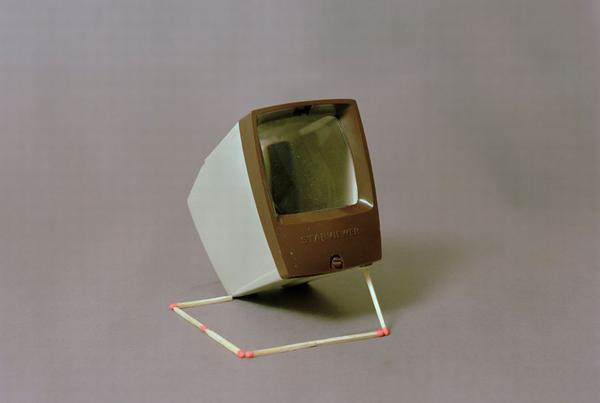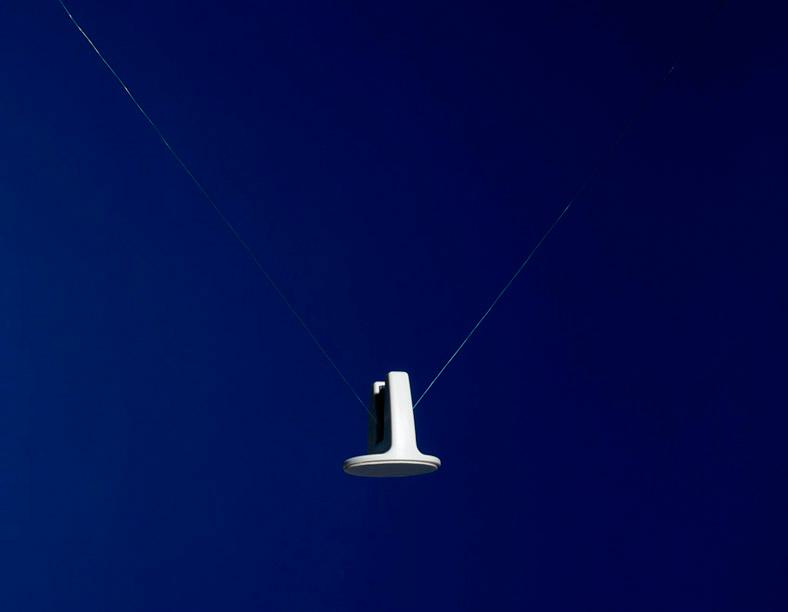David Penny selected by Patrick Henry (2012)

David Penny, Parallel Circuit (from series Potential Devices), 2010
Patrick Henry, former Director of Open Eye Gallery, Liverpool, profiles the work of Manchester-based photographic artist David Penny.
Manchester-based artist David Penny makes absorbing, provocative still life photographs. It’s not easy to do this. Photographs are bound up with our desire to know something about the world out there - their lifeblood is contingency. The canon of photography (as art) is dominated by the documentary tradition. The further still life photography gets from the language of documentary, the more it swims against the tide. Still life at worst circumscribes an airless space, cut off from the world, accessible only by the obscure, absolute desire of the photographer.
Penny has found some unusual ways to breathe life into this space. He creates simple, meticulous compositions, photographing single objects against plain backgrounds, populating his frame with undecided objects - objects that pose questions and engage the imagination. His approach is tentative and interrogative - it makes us look again at what surrounds us and where it has come from. It's photography from first principles - innocent photography, strangely reminiscent of the earliest experiments in photographic picture-making by Niepce, Talbot and others.

David Penny, this/that, 2009
Digital C-Print, Diasec mounted, 90 x 70 x 0.8 cm
In his series 'this/that' (2009) Penny presents a series of 'basic domestic tools', all of them made from white or light grey plastic. They appear almost weightless, suspended by fine threads against a cobalt-blue background. They are familiar but difficult to identify, and there's something faintly disturbing about them. Penny asks us to guess what these strange/familiar objects are, and creates an obscure kind of poetry from them. He invites us to consider them as sculptural objects - a familiar game, which Penny approaches with a refreshing, studied naivety.
There's nothing earnest or dogmatic about Penny's work. It's not closed, despite its strictly controlled vocabulary. Much of it revolves around puzzles, and it's always underpinned by the central puzzle of the tabula rasa, the empty space of the photograph. Each of his works asks what can be done with this space. What does the space do to the thing? What does the thing do to the space? In a way these are the biggest (and smallest) questions that you can ask of any medium - they return us to the question 'what is a photograph?'.
Another series, Devices for Progress (2009), was inspired by visits made to science and engineering museums to investigate the design of handheld consumer electronic devices. To his surprise, Penny found that the objects on display and in archives, in most cases, looked exactly like the final product. Disappointed, he set about (re)creating some of the images that existed in his imagination. Here the transformation that Penny effects is more explicitly playful and humorous. Each assemblage is a plausible fiction, but also an assertion of what should be. We have comforting myths about science and technology. They allow us to relate a bewildering world of sealed, opaque objects (of the kind which feature in the series this/that) to the homespun, the improvised, the everyday. They obscure the process of production and the true origins of industrial commodities. They are fairy tales, and by insisting on them Penny both embraces and exposes them.
Photography has become excessive, all embracing, omnipresent. Determined to narrow the field, and the question, Penny chooses to work only with the materials that are within immediate reach. It's as if, perceiving that photography has consumed too much of the world, Penny has decided to empty it out and start again. There's a deliberate poverty about this. It's like the best kind of play - the kind that makes use of whatever comes to hand, and transforms it. Penny's playthings are humble, everyday objects: things that are found and brought home, things that are just there, things that are supposed to be doing something else. He recovers them, studies them and re-invests them with mystery, beauty and utility.
Patrick Henry, 2012
About David Penny
David Penny (b. 1979) is a photographic artist based in Manchester. Having studied photography at Manchester School of Art and The University of Westminster he is currently undertaking a Practice as Research PhD at MIRIAD, Manchester.
In 2012 Penny will be exhibiting at Open Eye Gallery, Liverpool; ShanghART Gallery, Shanghai; Sheffield Institute of the Arts and with Curve Gallery, Newcastle, Australia.
Penny's work has previously been shown at Manchester Art Gallery, Bridewell Gallery - Liverpool, Wolstenholme Projects - Liverpool and Curve Gallery as part of the 2010 Liverpool Biennial.
About Patrick Henry
Patrick is the former Director of Open Eye Gallery, Liverpool. Before that he was Curator of Exhibitions at the National Media Museum (Bradford) and for six years prior to that he was a freelance photographer, based in Manchester.
He studied History of Art (BA) and Cultural History (MA) at the University of Manchester and has written numerous catalogue essays and contributed to publications such as The Art Newspaper, Museums Journal and Portfolio. He has been a member of the Liverpool Biennial’s curatorial team since 2004 and is a board member of Mercy (Creative Agency, Liverpool/London) and LOOK (International photography festival, Liverpool).
These biographies were written in (2012) as part of the Open Frequency programme. For the most current information, please visit:
Open Frequency (2004–2014)
This profile was part of Open Frequency, an Axis programme that highlighted emerging developments in contemporary art practice across the UK. Artists were selected and profiled by leading curators, artists, and writers, offering unique insights into the practices shaping contemporary art at the time. These archives remain a valuable resource for understanding the trajectory of some of the most exciting artists of the period.
Helping Artists Keep Going
Axis is an artist-led charity supporting contemporary visual artists with resources, connection, and visibility.


